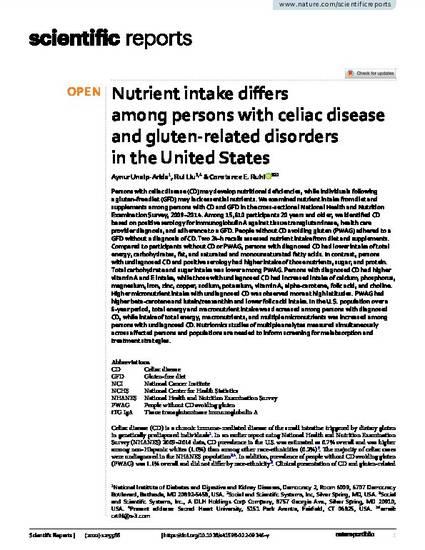
Persons with celiac disease (CD) may develop nutritional deficiencies, while individuals following a gluten-free diet (GFD) may lack essential nutrients. We examined nutrient intake from diet and supplements among persons with CD and GFD in the cross-sectional National Health and Nutrition Examination Survey, 2009-2014. Among 15,610 participants 20 years and older, we identified CD based on positive serology for immunoglobulin A against tissue transglutaminase, health care provider diagnosis, and adherence to a GFD. People without CD avoiding gluten (PWAG) adhered to a GFD without a diagnosis of CD. Two 24-h recalls assessed nutrient intake from diet and supplements. Compared to participants without CD or PWAG, persons with diagnosed CD had lower intake of total energy, carbohydrates, fat, and saturated and monounsaturated fatty acids. In contrast, persons with undiagnosed CD and positive serology had higher intake of those nutrients, sugar, and protein. Total carbohydrate and sugar intake was lower among PWAG. Persons with diagnosed CD had higher vitamin A and E intake, while those with undiagnosed CD had increased intake of calcium, phosphorus, magnesium, iron, zinc, copper, sodium, potassium, vitamin A, alpha-carotene, folic acid, and choline. Higher micronutrient intake with undiagnosed CD was observed more at high latitudes. PWAG had higher beta-carotene and lutein/zeaxanthin and lower folic acid intake. In the U.S. population over a 6-year period, total energy and macronutrient intake was decreased among persons with diagnosed CD, while intake of total energy, macronutrients, and multiple micronutrients was increased among persons with undiagnosed CD. Nutriomics studies of multiple analytes measured simultaneously across affected persons and populations are needed to inform screening for malabsorption and treatment strategies.
Unalp-Arida, A., Liu, R., & Ruhl, C. E. (2022). Nutrient intake differs among persons with celiac disease and gluten-related disorders in the United States. Scientific Reports, 12(1), 5566. https://doi.org/10.1038/s41598-022-09346-y

This article is open access licensed under a Creative Commons Attribution 4.0 International License.